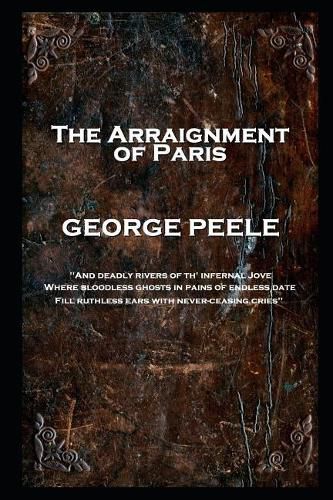George Peele - The Arraignment of Paris: 'And deadly rivers of th' infernal Jove, Where bloodless ghosts in pains of endless date, Fill ruthless ears with never-ceasing cries
George Peele

George Peele - The Arraignment of Paris: ‘And deadly rivers of th’ infernal Jove, Where bloodless ghosts in pains of endless date, Fill ruthless ears with never-ceasing cries
George Peele
George Peele was born in July 1556 and baptised on the 25th at St James Garlickhythe in the City of London. A completely accurate record of his life is not possible but enough accounts and records exist to provide some background.
His father, James was a clerk at Christ’s Hospital, then a central London school, and authored two treatises on bookkeeping.
Peele himself was initially educated at Christ’s Hospital before entering Broadgates Hall, Oxford, in 1571. Three years after in 1574 he moved to Christ Church and took his B.A. there in 1577, and then his M.A. in 1579. Something appears to have so upset the Governors that they requested their clerk to ‘discharge his house of his son, George Peele.’
His mother, Anne, died on July 1st, 1580, and his father remarried to Christian Widers, a nurse at the hospital a few months later.
Peele himself appears to have married, around this time, Ann Cooke, a heiress. He appears to have been rather reckless with her assets and they were soon gone.
What he did appear to be hard at work on was his writing. His pastoral comedy ‘The Arraignment of Paris’ was presented by the Children of the Chapel Royal before Queen Elizabeth perhaps by 1581, and was printed anonymously in 1584.
He was praised in 1585 for his translation from the Greek of one of the ‘Iphigenias of Euripides’. That same year, 1585, he was employed to write the ‘Device of the Pageant’, and in 1591 he devised a pageant in honour of another Lord Mayor, Sir William Webbe. This was the ‘Descensus Astraeae’, in which Queen Elizabeth is honoured as Astraea.
Much of the rest of his life is not certain and various facts, accounts and information is in dispute.
He may have married for a second time but what happened to Ann is not recorded. He was also awarded the authorship of several plays many of which have now fallen away although modern research methods. However, knowing the collaboration between many of the dramatists of that time his hand has been detected and confirmed in some other plays.
Perhaps the most famous of these is Shakespeare’s ‘Titus Andronicus’. It is now thought that Peele wrote the first act as well as the first two scenes in Act II, with Shakespeare responsible for the rest. The exact measure of each is difficult to ascertain any further.
As a writer he is acknowledged to be one of the era’s finest and ranked alongside Marlowe, Spenser, and Shakespeare.
The other plays for which Peele can reliably be given authorship are ‘Edward I’, (printed 1593) ‘The Old Wives’ Tale’, ‘The Battle of Alcazar’ (printed 1594) and David and Bethsabe (printed 1599). ‘The Troublesome Reign of John, King of England’, the immediate source for Shakespeare’s King John, has been published under Peele’s name.
George Peel died, accounts say of the pox, and was buried on the 9th November 1596 in St James’s Church, Clerkenwell.
This item is not currently in-stock. It can be ordered online and is expected to ship in approx 2 weeks
Our stock data is updated periodically, and availability may change throughout the day for in-demand items. Please call the relevant shop for the most current stock information. Prices are subject to change without notice.
Sign in or become a Readings Member to add this title to a wishlist.


